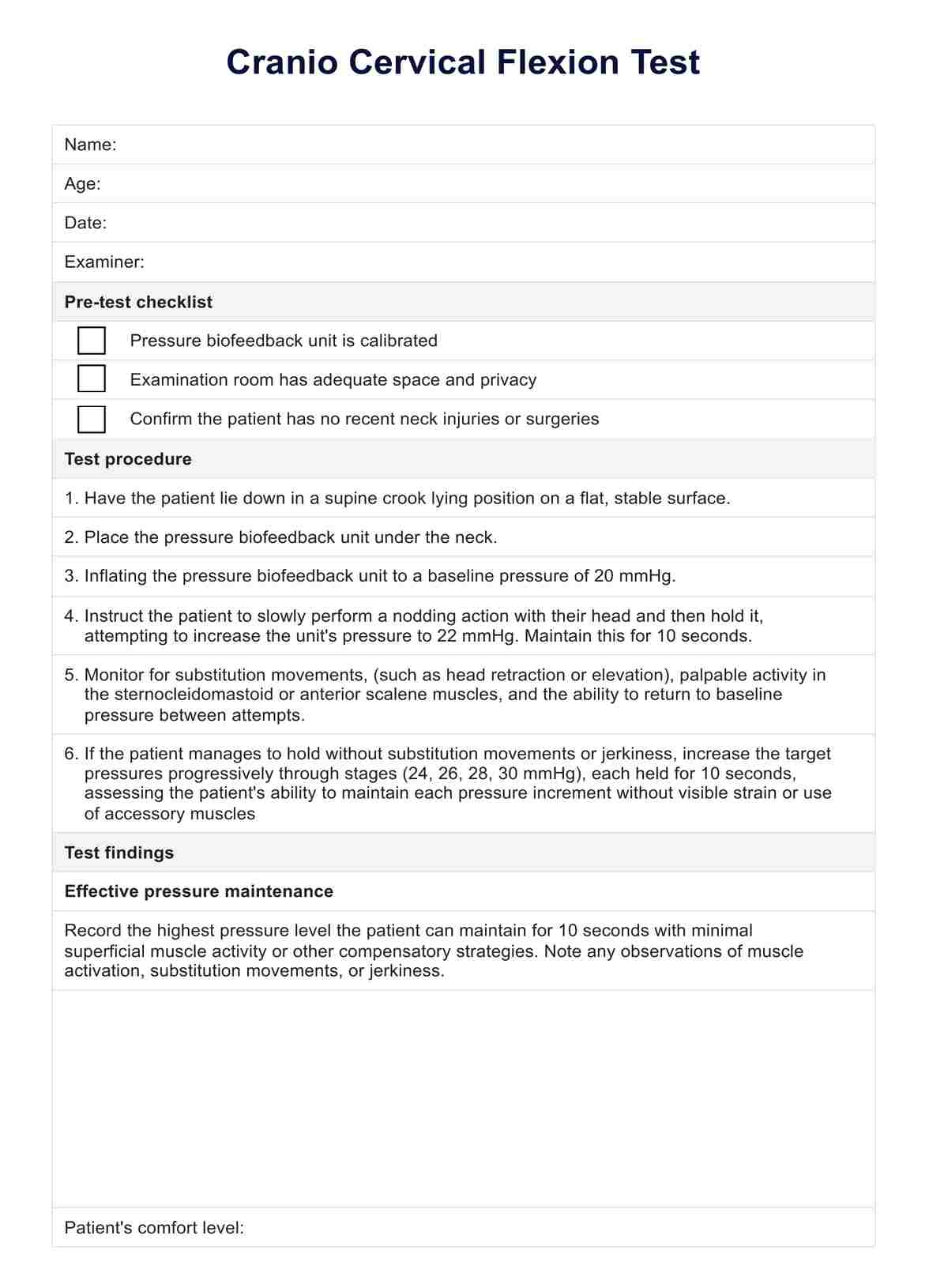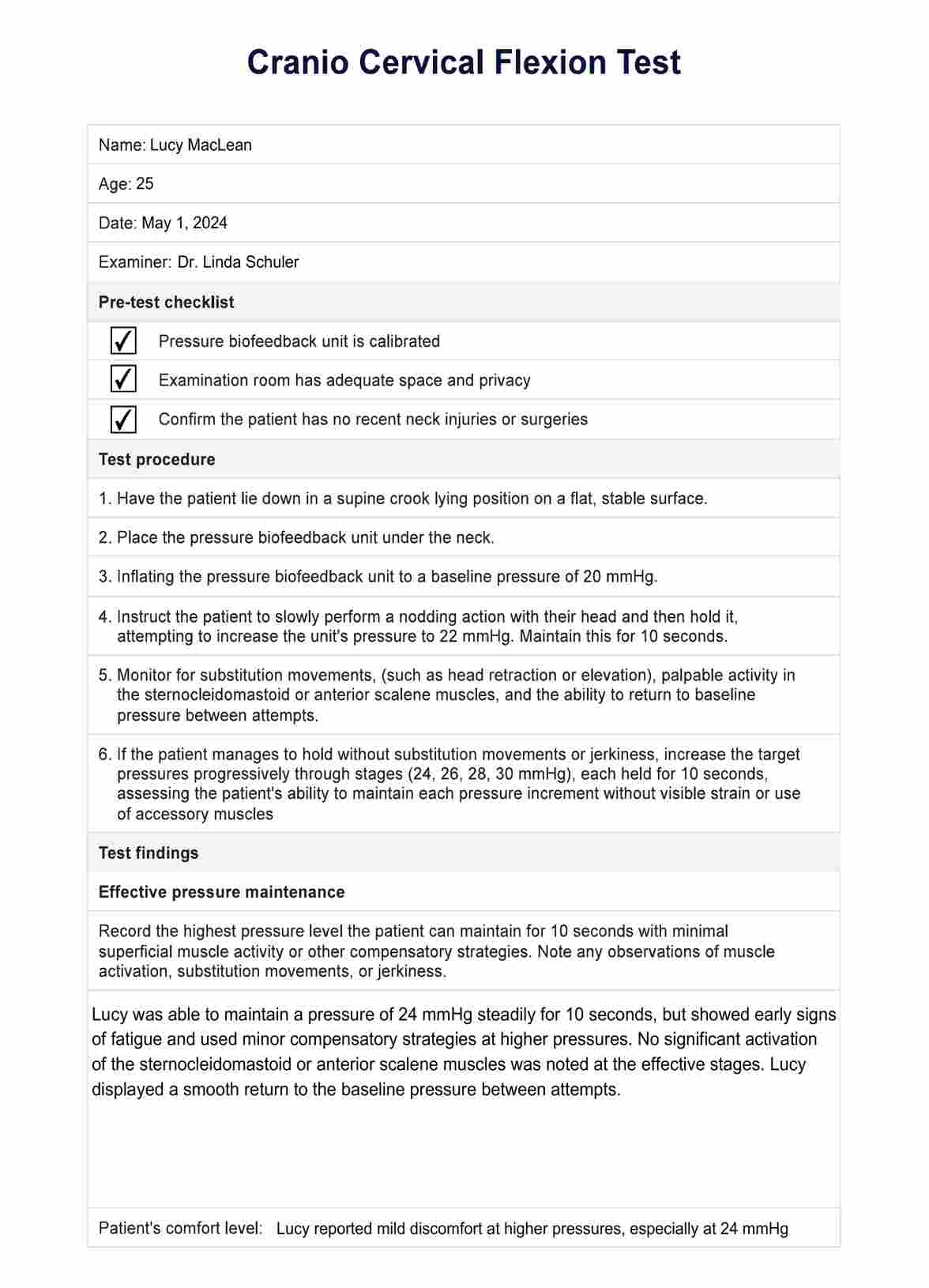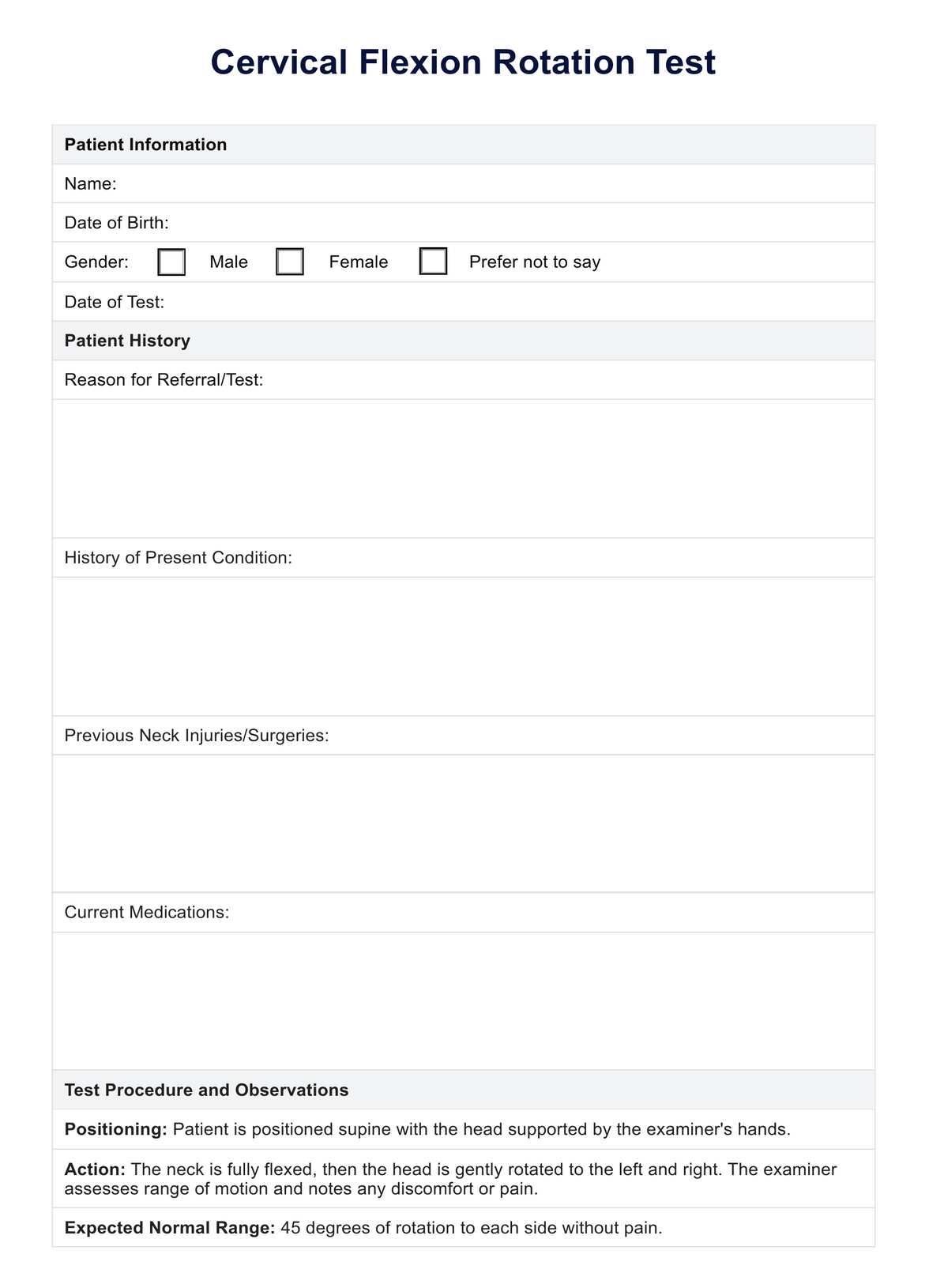Cranio Cervical Flexion Test
Streamline your clinical assessments with our Cranio Cervical Flexion Test template. Perfect for evaluating neck muscle function efficiently and accurately.


What are deep cervical flexor muscles?
The deep cervical flexor muscles, also known as the deep neck flexors, primarily consisting of the longus colli and longus capitis, are vital muscles located along the front of the cervical spine (the neck). These muscles play a crucial role in the stabilization and movement control of the neck. They are deeply seated, lying directly adjacent to the cervical vertebrae, and are integral to maintaining good neck posture and alignment.
The deep cervical flexors are responsible for flexing the neck and helping to control the posture of the head. Their strength and endurance are essential for neck health, especially in individuals who may experience chronic neck pain or recovering from neck injuries. These muscles are also crucial in reducing the load on the cervical spine by providing necessary support and stabilization, which helps prevent injury and manage conditions such as cervical spondylosis or whiplash.
Cranio Cervical Flexion Test Template
Cranio Cervical Flexion Test Example
What is the Cranio Cervical Flexion Test?
The Cranio Cervical Flexion Test (CCFT) is a clinical test designed to evaluate the function and endurance of the deep cervical flexor muscles in the neck. This test is particularly valuable for diagnosing underlying issues with these muscles, which are often implicated in cases of chronic neck pain and cervical spine disorders.
The CCFT is used not only to assess the strength and control of the deep cervical flexors but also to help design and monitor rehabilitation programs for patients with neck dysfunction. By progressively increasing the demand on these muscles through several stages, the test provides detailed insights into the patient’s ability to activate and sustain muscle activity in the cervical flexors.
How to conduct the Cranio Cervical Flexion Test?
Before initiating the test, it’s essential to ensure that the patient is comfortable. Then, set up necessary equipment—you will need a calibrated biopressure feedback unit, which has a pressure sensor. The test involves the following steps:
- The patient lies down in a supine crook lying position.
- A pressure biofeedback unit is placed behind the neck and initially set to a baseline pressure of 20 mmHg.
- The patient performs a series of graded cervical flexion movements, starting from a slight nod forward to a more significant flexion, aiming to incrementally increase the pressure indicated by the unit by 2 mmHg per stage and holding each stage for 10 seconds.
- Throughout the test, the patient’s ability to increase and maintain the pressure without activating superficial cervical flexors or making substitution movements is assessed.
This is only an overview of the procedure; our Cranio Cervical Flexion Test template contains the complete, detailed procedure.
What are the possible results and interpretations?
The results from the Cranio Cervical Flexion Test can vary:
- A positive outcome shows the patient can successfully perform the tasks with correct muscle activation, indicating good muscle function.
- A negative outcome may reveal difficulties in maintaining the set pressures, indicating potential weakness, lack of endurance, or improper muscle function. This also includes use of superficial neck flexors such as the sternocleidomastoid and anterior scalene muscles.
Understanding the nuances of the CCFT allows healthcare providers to accurately assess and address the specific needs of their patients experiencing neck issues.
How does our Cranio Cervical Flexion Test template work?
Our Cranio Cervical Flexion Test template is meticulously designed to facilitate the accurate assessment and documentation of the deep cervical flexor muscles' function. The template includes sections for preparation checklist, the procedure, and fillable fields for documenting the findings, making it an essential tool for healthcare professionals.
Step 1: Access this template
Healthcare professionals can access the template through the Carepatron platform, available for both digital and printable use. This flexibility allows the template to be integrated easily into different clinical settings, enhancing its accessibility and utility during patient assessments.
Step 2: Explain the template
Before beginning the assessment, it's important for healthcare providers to explain the template's structure and purpose to the patient or other team members. This ensures that everyone involved understands the test's objectives and how the findings will be recorded, setting the stage for a smooth and effective evaluation.
Step 3: Prepare for the test
Use the pre-test checklist included in the template to ensure that all necessary preparations are made. This may involve calibrating the pressure biofeedback unit, ensuring the examination room is suitable, and confirming that the patient has no recent neck injuries that might affect the test.
Step 4: Conduct the test
Follow the procedural steps outlined in the template to perform the Cranio Cervical Flexion Test. This involves setting the biofeedback unit, guiding the patient through the graded flexion movements, and monitoring their ability to maintain specific pressures without compensatory strategies.
Step 5: Document the findings
Record the patient's performance at each pressure level, noting any difficulties or compensatory movements observed. The template's fields for effective pressure maintenance provide space to detail the highest pressure the patient could maintain and any significant observations about muscle activation or movement quality.
By using this template, healthcare professionals can ensure a comprehensive and standardized approach to conducting the Cranio Cervical Flexion Test, enhancing the reliability of the assessment and the effectiveness of subsequent treatment plans for patients with neck dysfunction.
Next steps
After conducting the Cranio Cervical Flexion Test and documenting the findings, it's crucial to determine the appropriate next steps based on the results. These steps are essential for ensuring effective management and rehabilitation of any identified issues with the deep cervical flexor muscles. Here are the recommended actions:
- Develop a customized rehabilitation plan: Based on the test results, create a personalized rehabilitation program aimed at strengthening the deep cervical flexors. This may include specific exercises that focus on improving muscle endurance and reducing compensatory muscle usage.
- Schedule follow-up assessments: Regular follow-up assessments are vital to monitor neck pain patients' progress and adjust the rehabilitation plan as needed. This ensures patients continue to improve and achieves the best possible outcomes.
- Educate the patient: Provide education about the importance of neck posture and the role of cervical flexors in overall cervical health. Teaching patients about the mechanics of their condition and how to manage it can enhance their engagement and adherence to the treatment plan.
- Incorporate adjunct therapies: Consider integrating other therapeutic modalities such as manual therapy, posture correction, or ergonomic adjustments to support the rehabilitation process. These therapies can help address any additional factors contributing to the patient's neck issues.
- Evaluate the need for further diagnostic testing: If the test results indicate severe dysfunction or if there is no improvement with rehabilitation, further diagnostic evaluations may be necessary to rule out other underlying conditions or other neck pain disorders.
By following these steps, healthcare professionals can provide comprehensive care that not only addresses the immediate findings of the Cranio Cervical Flexion Test but also promotes long-term cervical health and functionality.
Commonly asked questions
Craniocervical instability is diagnosed through a combination of physical examinations, patient history, imaging tests like MRI or CT scans, and specific functional tests that assess the stability of the cervical spine.
The craniocervical flexion test is a clinical assessment used to evaluate the strength and coordination of the deep cervical flexor muscles, crucial for supporting the cervical spine and maintaining neck posture.
Treatment for cranio cervical instability typically includes physical therapy to strengthen neck muscles, possibly wearing a cervical collar, pain management, and in severe cases, surgical interventions to stabilize the spine.








































































































